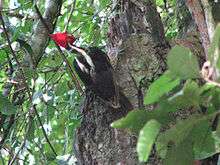Pale-billed woodpecker
The pale-billed woodpecker (Campephilus guatemalensis) is a very large woodpecker that is a resident breeding bird from northern Mexico to western Panama.
| Pale-billed woodpecker | |
|---|---|
 | |
| Scientific classification | |
| Kingdom: | Animalia |
| Phylum: | Chordata |
| Class: | Aves |
| Order: | Piciformes |
| Family: | Picidae |
| Genus: | Campephilus |
| Species: | C. guatemalensis |
| Binomial name | |
| Campephilus guatemalensis (Hartlaub, 1844) | |
Habitat
The habitat of this species is wet forests and adjacent second growth or semi-open woodland. Two white eggs are laid in an unlined nest hole 3–30 m (9.8–98.4 ft) high in a tree and incubated by both sexes. The young hatch naked and are fed by both parents.
Description
The pale-billed woodpecker is 37 cm (15 in) long and weighs 255 g (9.0 oz). It resembles the lineated woodpecker, but is larger and more robust.
The adult is mainly black above with a pale bill, bushy crest, and white lines down the shoulders which almost meet in a V on its back. The throat is black and the rest of the underparts are white, heavily barred with black. The male has a red head and crest; the female is similar, but the crest and throat are black. The female can be distinguished from the lineated woodpecker by the absence of a white facial stripe.
This bird has a characteristic drumming with two quick powerful taps. Its calls include nasal rattles and a keeu keeu keeu keeu breeding call.
Pale-billed woodpeckers chip out holes, often quite large, while searching out insects in trees. They mainly eat beetle larvae, with some berries, lizards, or other fruit.
This bird has been adversely affected by deforestation in parts of its range.
References
- BirdLife International (2012). "Campephilus guatemalensis". IUCN Red List of Threatened Species. 2012. Retrieved 26 November 2013.CS1 maint: ref=harv (link)
- Stiles and Skutch, A guide to the birds of Costa Rica, ISBN 0-8014-9600-4
- Fogden SCL, Fogden M & Fogden P. A Photographic Gude to Birds of Costa Rica, London: New Holland Publishers, 2005
External links
| Wikimedia Commons has media related to Pale-billed woodpecker. |
| Wikispecies has information related to Campephilus guatemalensis |
- "Pale-billed woodpecker media". Internet Bird Collection.
- Pale-billed woodpecker photo gallery at VIREO (Drexel University)
- Pale-billed woodpecker species account at Neotropical Birds (Cornell Lab of Ornithology)
- Interactive range map of Campephilus guatemalensis at IUCN Red List maps

